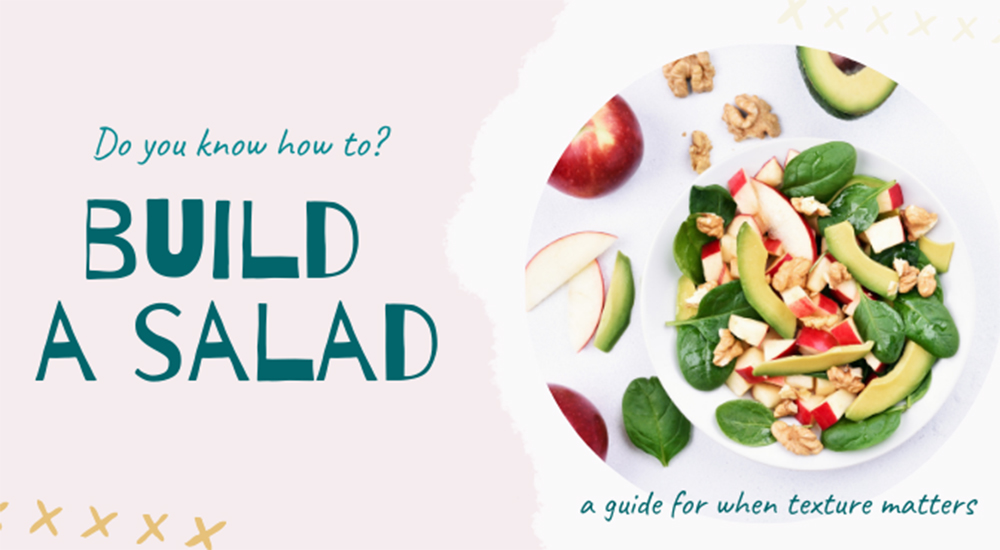March is National Nutrition Month… a great time to focus on your personal nutrition and wellness. There is no one-size-fits-all approach. Personalizing your plate can be a journey, especially for those with a selective palate or texture sensitivities.
As a registered dietitian, I understand that the statement, “I don’t like to eat vegetables,” can go a little deeper.
For some people, making a salad is a fun and easy experience. Throw it all in a bowl and there you go! For others, there is special attention paid to the sizes of individual food pieces, texture, temperature, and flavor combinations when sitting down for a meal.
Here are some things to consider when personalizing your salad bowl to make eating vegetables a pleasure, not a chore.
-
Build a Base with Greens
Lettuce has many textures and flavors. Iceberg and Romaine are mild and generally crunchy. You can chop them down to a very fine salad. Mixed greens are a great way to introduce deeper colors, while still keeping a mild flavor and softer texture.
Dark green leafy vegetables hold many nutritional benefits, including fiber, vitamins, minerals and phytonutrients. Spinach and kale are budget friendly, and extras can be frozen and used in smoothies.
-
Add Color and Fiber
Chopped salads include items of similar sizes and help make the salad building process less intimidating! Start with any vegetables you do like and slowly add more each week to boost the nutritional value of your meal.
There are many ways to add more color to your plate. For example, the lycopene in red tomatoes helps clear free radicals in the body that can harm our cells. For people who do eat fruit, but not as many vegetables, consider adding fruit to the salad to increase acceptance from your taste buds.
Diced apples and fresh pear provide the perfect crunch with a sweet finish.
-
Protein Options
Whether it’s plant based, meat, poultry or seafood, protein can help keep you satisfied. Animal protein, such as tuna, grilled or baked chicken, lean steak – all of these can be added either cold or hot, and can be diced, sliced or shredded.
Beans and legumes, such as edamame or black beans, can add extra protein and fiber to your salad.
Nuts and seeds, such as sunflower seeds, pepitas, or chopped walnuts can add sources of magnesium, zinc, selenium and copper. As you start to experiment with taste and textures, think outside the box. If you enjoy the taste of eggs, but are unsure of putting a whole hardboiled egg on your salad, dice it up finely to start.
-
Dress Your Salad
Dressings may add too strong of a flavor for beginners who typically eat salads dry. Consider combining olive oil with herbs and/or spices first. Then expand on that flavor with the addition of vinegar or fruit to make a vinaigrette, such as the lemony dressing in this green salad recipe.
Continue to expand the flavor profile by adding items, like lemon, limes, ginger, garlic, turmeric and more.
With practice, creating different salads will become more fun and less challenging. You might even make your mornings more colorful with a rainbow breakfast salad.
For more great recipes, check out our VA YouTube page.
Lindsey Purcell is a clinical nutrition supervisor and registered dietitian. In addition to serving her outpatient clinic, she is the executive producer for the Fresh Focus Podcast. She specializes in helping Veterans transition into eating healthier, one step at a time.
Topics in this story
More Stories
Study underscores important role COVID vaccination can have in protecting Veterans from infection and reducing long-term health consequences
Columbia VA’s robotic surgery teams completed their 800th robotic surgery and are on schedule to hit 1,000 by the end of the year.
In a decentralized clinical trial, Veterans can participate from their own homes or local VA instead of having to travel to a research site.








Good Healthy information. Recipe will help me make my salad better. Thank You